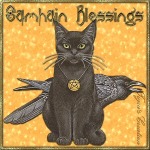 Samhain will soon be here and I’m starting to prepare foods and rituals.
Samhain will soon be here and I’m starting to prepare foods and rituals.
For those of you not so familiar with Samhain, here’s a brief outline of the Sabbat:
Samhain is known by most folks as Halloween, but for Wiccans and Pagans it’s considered a Sabbat to honor the ancestors who came before us. It’s a good time to contact the spirit world with a seance, because it’s the time when the veil between this world and the next is at its thinnest.
Religious scholars agree that the word Samhain (pronounced “sow-en”) comes from the Gaelic “Samhuin,” but they’re divided on whether it means the end or beginning of summer. After all, when summer is ending here on earth, it’s just beginning in the Underworld. Samhain actually refers to the daylight portion of the holiday, on November 1st.
All Hallow Mass
Around the eighth century or so, the Catholic Church decided to use November 1st as All Saints Day. This was actually a pretty smart move on their part – the local pagans were already celebrating that day anyway, so it made sense to use it as a church holiday. All Saints’ became the festival to honor any saint who didn’t already have a day of his or her own. The mass which was said on All Saints’ was called Allhallowmas – the mass of all those who are hallowed. The night before naturally became known as All Hallows Eve, and eventually morphed into what we call Halloween
The Witch’s New Year
Sunset on Samhain is the beginning of the Celtic New Year. The old year has passed, the harvest has been gathered, cattle and sheep have been brought in from the fields, and the leaves have fallen from the trees. The earth slowly begins to die around us.
 As you can see from the pictures on this page, there is the iconic black cat associated with witches and Halloween.
As you can see from the pictures on this page, there is the iconic black cat associated with witches and Halloween.
The Witch’s Familiar
Around the time of the Middle Ages, the cat became associated with witches and witchcraft. Around the late 1300’s, a group of witches in France were accused of worshipping the Devil in the form of a cat. It may be because of the cat’s nocturnal nature that it became connected to witches — after all, night time was the time they held their meetings, as far as the church was concerned.
Black Cat Folklore and Legends
Sixteenth-century Italians believed that if a black cat jumped on the bed of an ill person, the person would soon die.
In Colonial America, Scottish immigrants believed that a black cat entering a wake was bad luck, and could indicated the death of a family member.
The Norse goddess Freyja drove a chariot pulled by a pair of black cats.
A Roman solder killed a black cat in Egypt, and was killed by an angry mob of locals.
Appalachian folklore said that if you had a stye on the eyelid, rubbing the tail of a black cat on it would make the stye go away.
If you find a single white hair on your otherwise-black cat, it’s a good omen.
In England’s border countries and southern Scotland, a strange black cat on the front porch brings good fortune.
To be continued /…